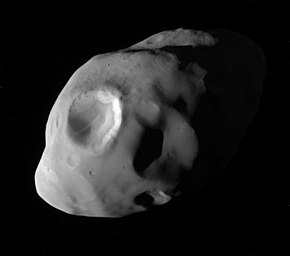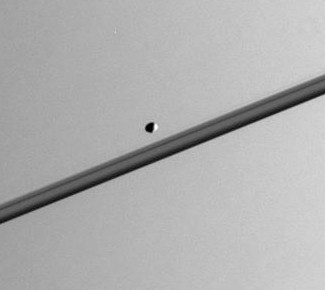 View of Pandora's western hemisphere. View of Pandora's western hemisphere. | |
| Discovery | |
|---|---|
| Discovered by | Stewart A. Collins D. Carlson Voyager 1 |
| Discovery date | October, 1980 |
| Designations | |
| Designation | Saturn XVII |
| Pronunciation | /pænˈdɔːrə/ |
| Named after | Πανδώρα Pandōra |
| Adjectives | Pandoran |
| Orbital characteristics | |
| Epoch December 31, 2003 (JD 2453005.5) | |
| Semi-major axis | 141720±10 km |
| Eccentricity | 0.0042 |
| Orbital period (sidereal) | 0.628504213 d |
| Inclination | 0.050°±0.004° to Saturn's equator |
| Satellite of | Saturn |
| Group | Possible outer shepherd moon of the F Ring |
| Physical characteristics | |
| Dimensions | 103.0 × 79.0 × 63.0 km (± 0.6 × 0.6 × 0.4 km) |
| Mean diameter | 80.0±0.6 km |
| Volume | 268990±860 km |
| Mass | (1.357±0.002)×10 kg |
| Mean density | 0.5045±0.0017 g/cm |
| Surface gravity | 0.0022–0.0061 m/s |
| Escape velocity | 0.019 km/s at longest axis to 0.024 km/s at poles |
| Synodic rotation period | synchronous |
| Axial tilt | zero |
| Albedo | 0.6 |
| Temperature | ≈ 78 K |
Pandora is an inner satellite of Saturn. It was discovered in 1980 from photos taken by the Voyager 1 probe and was provisionally designated S/1980 S 26. In late 1985, it was officially named after Pandora from Greek mythology. It is also designated as Saturn XVII.
Pandora was thought to be an outer shepherd satellite of the F Ring. However, recent studies indicate that it does not play such a role, and that only Prometheus, the inner shepherd, contributes to the confinement of the narrow ring. It is more heavily cratered than nearby Prometheus and has at least two large craters 30 kilometres (19 mi) in diameter. The majority of craters on Pandora are shallow as a result of being filled with debris. Ridges and grooves are also present on the moon's surface.
The orbit of Pandora appears to be chaotic as a consequence of a series of four 118:121 mean-motion resonances with Prometheus. The most appreciable changes in their orbits occur approximately every 6.2 years, when the periapsis of Pandora lines up with the apoapsis of Prometheus and the moons approach to within about 1,400 kilometres (870 mi). Pandora also has a 3:2 mean-motion resonance with Mimas.
From its very low density and relatively high albedo, it seems likely that Pandora is a very porous icy body. However, there is much uncertainty in these values, so this remains to be confirmed.
Gallery
-
 Voyager 2 image of Pandora (August 1981).
Voyager 2 image of Pandora (August 1981).
-
 View of the moon, taken during September 2005 flyby by Cassini.
View of the moon, taken during September 2005 flyby by Cassini.
-
 Pandora as seen from the Cassini probe in 2005; the rings of Saturn are in the background.
Pandora as seen from the Cassini probe in 2005; the rings of Saturn are in the background.
-
 Cassini captured this close view of Saturn's moon Pandora during the spacecraft's flyby on June 3, 2010.
Cassini captured this close view of Saturn's moon Pandora during the spacecraft's flyby on June 3, 2010.
References
Listen to this article (2 minutes)Notes
- This view was taken by Cassini, during the spacecraft's close flyby on December 18, 2016. The image was taken from a distance of 40,500 kilometres (25,200 miles); the closest approach by the spacecraft during its 14-year tenure in the Saturn system.
- Calculated from the standard gravitational parameter GM = (9.058±0.011)×10 km·s given by Lainey et al. (2023), divided by the gravitational constant G = 6.6743×10 km·kg·s.
Citations
- Robert Kolvoord (1990) Saturn's F ring: imaging and simulation, p. 104
- ^ Spitale Jacobson et al. 2006.
- ^ Thomas & Helfenstein 2020.
- ^ Lainey et al. 2023.
- IAUC 3532.
- IAUC 4157.
- USGS: Planet and Satellite Names and Discoverers.
- Lakdawalla, E. (2014-07-05). "On the masses and motions of mini-moons: Pandora's not a "shepherd," but Prometheus still is". Planetary Society. Retrieved 2015-04-17.
- Cuzzi, J. N.; Whizin, A. D.; Hogan, R. C.; Dobrovolskis, A. R.; Dones, L.; Showalter, M. R.; Colwell, J. E.; Scargle, J. D. (April 2014). "Saturn's F Ring core: Calm in the midst of chaos". Icarus. 232: 157–175. Bibcode:2014Icar..232..157C. doi:10.1016/j.icarus.2013.12.027. ISSN 0019-1035.
- Solar System, NASA: Pandora.
- Renner et al. 2005.
Sources
- Marsden, Brian G. (October 31, 1980). "Satellites of Saturn" (discovery). IAU Circular. 3532. Retrieved 2011-12-29.
- Marsden, Brian G. (January 3, 1986). "Satellites of Saturn and Pluto" (naming the moon). IAU Circular. 4157. Retrieved 2011-12-29.
- Renner, Stéfan F.; Sicardy, Bruno; French, Richard G. (March 2005). "Prometheus and Pandora: Masses and orbital positions during the Cassini tour". Icarus. 174 (1): 230–240. Bibcode:2005Icar..174..230R. doi:10.1016/j.icarus.2004.09.005.
- "Saturn: Moons: Pandora". Solar System Exploration: Planets. NASA. 4 Apr 2011. Archived from the original on 2 June 2015. Retrieved 2011-12-29.
- Spitale, J. N.; Jacobson, R. A.; Porco, C. C.; Owen, W. M. Jr. (2006). "The orbits of Saturn's small satellites derived from combined historic and Cassini imaging observations". The Astronomical Journal. 132 (2): 692–710. Bibcode:2006AJ....132..692S. doi:10.1086/505206.
- Thomas, P. C. (July 2010). "Sizes, shapes, and derived properties of the saturnian satellites after the Cassini nominal mission" (PDF). Icarus. 208 (1): 395–401. Bibcode:2010Icar..208..395T. doi:10.1016/j.icarus.2010.01.025.
- USGS/IAU (July 21, 2006). "Planet and Satellite Names and Discoverers". Gazetteer of Planetary Nomenclature. USGS Astrogeology. Retrieved 2011-12-29.
- Thomas, P. C.; Helfenstein, P. (July 2020). "The small inner satellites of Saturn: Shapes, structures and some implications". Icarus. 344: 20. Bibcode:2020Icar..34413355T. doi:10.1016/j.icarus.2019.06.016. S2CID 197474587. 113355.
- Lainey, V.; Rambaux, N.; Cooper, N.; Dahoumane, R.; Zhang, Q. (February 2023). "Characterising the interior of five inner Saturnian moons using Cassini ISS data". Astronomy & Astrophysics. 670: 6. Bibcode:2023A&A...670L..25L. doi:10.1051/0004-6361/202244757. L25.
External links
| Moons of Saturn | |||||||
|---|---|---|---|---|---|---|---|
| Listed in approximate increasing distance from Saturn | |||||||
| Ring moonlets | |||||||
| Ring shepherds | |||||||
| Other inner moons | |||||||
| Alkyonides | |||||||
| Large moons (with trojans) | |||||||
| Inuit group (13) |
| ||||||
| Gallic group (7) | |||||||
| Norse group (100) |
| ||||||
| Outlier prograde irregular moons |
| ||||||
| Saturn | |
|---|---|
| Geography | |
| Moons | |
| Astronomy | |
| Exploration | |
| Related | |